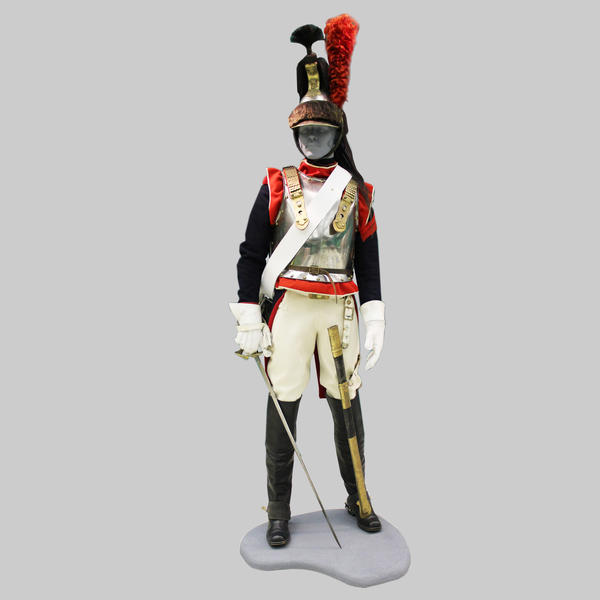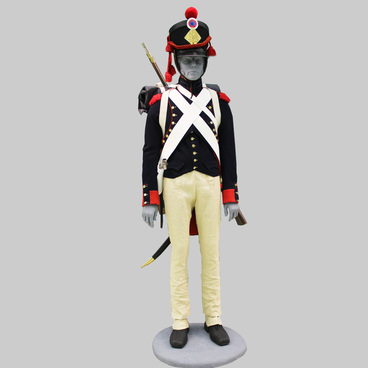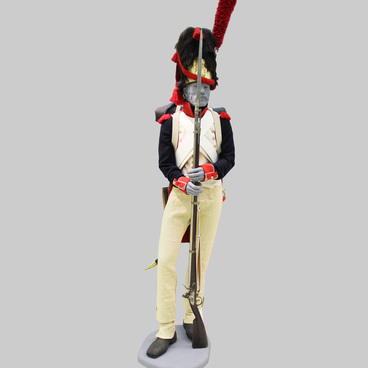Cuirassiers (in literal translation: ‘armor-clad warriors’, derived from the French cuirasse — ‘armor’) were heavy cavalry. Napoleon called his cuirassiers ‘iron people’ and, as they constituted the shock part of the cavalry, constantly increased the number of cuirassier regiments. In the Russian campaign, 13 French cuirassier regiments took part, apart from those of the allies.
In the Battle of Borodino on 26 August 1812, the 5th cuirassier regiment participated in the famous attack of General Auguste de Caulaincourt on one of the most important fortifications – Kurgannaya, or Rayevsky’s Battery.
Equipment and gear of French and Russian cuirassiers was, in general, similar, with only minor differences. Napoleon’s cuirassiers were considered elite part of the cavalry, so, instead of shoulder boards, they wore epaulettes of red color.
Cuirassier’s protective equipment comprised cuirass and helmet. A French cuirassier could be differentiated by a helmet with a horsehair plume in the shape of a “tail” hanging down to the neck. The plume was not only decoration, but also protected from saber cuts.
Helmets were made from steel, lined with bear fur and equipped with a tall copper crest on which the plume was fixed. Another distinctive feature of Napoleon’s army elite units was a hackle – decoration from rooster feathers attached to the helmet. The cuirassier is wearing the helmet model of 1809.
French cuirasses, unlike the Russian ones, were not painted. The soldier is wearing a cuirass of the model of 1807. This protective element of the equipment consisted of two iron plates worn on the chest and on the back, connected with leather straps on the shoulders and at the waist. Cuirass shoulder straps were covered with metal scales.
In 1812, cuirassiers were equipped with a broadsword and a cavalry musketoon of the model of the 9th year of the French Republic. Such definition of the weapons time of creation was determined by the revolution traditions which changed the usual chronology. 1792, when the Republic was established, was declared the ‘first year’ from which the time was counted.
Broadsword is a cold stabbing weapon with a long straight blade. According to the regulation, cuirassiers were to use an iron broadsword scabbard, but, in reality, they often used dragoons’, leather scabbards.
The cuirassier is also wearing a pantaler – leather shoulder-belt with a steel clip for fixing the gun. On the back, a cartridge pouch with a one-fire grenade is attached to the pantaler.
In the Battle of Borodino on 26 August 1812, the 5th cuirassier regiment participated in the famous attack of General Auguste de Caulaincourt on one of the most important fortifications – Kurgannaya, or Rayevsky’s Battery.
Equipment and gear of French and Russian cuirassiers was, in general, similar, with only minor differences. Napoleon’s cuirassiers were considered elite part of the cavalry, so, instead of shoulder boards, they wore epaulettes of red color.
Cuirassier’s protective equipment comprised cuirass and helmet. A French cuirassier could be differentiated by a helmet with a horsehair plume in the shape of a “tail” hanging down to the neck. The plume was not only decoration, but also protected from saber cuts.
Helmets were made from steel, lined with bear fur and equipped with a tall copper crest on which the plume was fixed. Another distinctive feature of Napoleon’s army elite units was a hackle – decoration from rooster feathers attached to the helmet. The cuirassier is wearing the helmet model of 1809.
French cuirasses, unlike the Russian ones, were not painted. The soldier is wearing a cuirass of the model of 1807. This protective element of the equipment consisted of two iron plates worn on the chest and on the back, connected with leather straps on the shoulders and at the waist. Cuirass shoulder straps were covered with metal scales.
In 1812, cuirassiers were equipped with a broadsword and a cavalry musketoon of the model of the 9th year of the French Republic. Such definition of the weapons time of creation was determined by the revolution traditions which changed the usual chronology. 1792, when the Republic was established, was declared the ‘first year’ from which the time was counted.
Broadsword is a cold stabbing weapon with a long straight blade. According to the regulation, cuirassiers were to use an iron broadsword scabbard, but, in reality, they often used dragoons’, leather scabbards.
The cuirassier is also wearing a pantaler – leather shoulder-belt with a steel clip for fixing the gun. On the back, a cartridge pouch with a one-fire grenade is attached to the pantaler.



